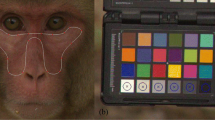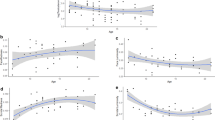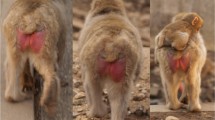Abstract
Most primates are both highly visual and highly social. These qualities predict that visual cues to social variables, such as identity, sex, social status, and reproductive quality, would be intrinsically valuable and systematically attract attention. Supporting this idea, thirsty male rhesus macaques (Macaca mulatta) will forego fluid reward to view images of the faces of high-ranking males and the sexual skin of females. Whether female rhesus macaques, who experience dramatically different social pressures and reproductive costs than male macaques, also systematically and spontaneously value visual cues to social information remains untested experimentally. We probed the preferences of female rhesus macaques, given the opportunity to display an image from a known class of social stimuli or touch a second target to display a blank screen. We found that females preferred faces of high-status males and also images of the perinea of both males and females, but were not motivated to display images of subordinate males or control stimuli. These findings endorse the view that both male and female rhesus macaques—and presumably other highly social primates—seek information about other individuals in a way that matches the adaptive value of that information for guiding social behavior.


Similar content being viewed by others
References
Aharon I, Etcoff N, Ariely D, Chabris CF, O’Connor E, Breiter HC (2001) Beautiful faces have variable reward value: fMRI and behavioral evidence. Neuron 32(3):537–551
Allman JM (2000) Evolving brains. W.H. Freeman, New York
Altmann J (1974) Observational study of behavior—sampling methods. Behaviour 49(3–4):227–267
Andrews M, Rosenblum L (1993) Live-social-video reward maintains joystick task performance in bonnet macaques. Percept Motor Skills 77:755–763
Barton R (1998) Visual specialization and brain evolution in primates. Proc R Soc B Biol Sci 265(1409):1933
Baulu J (1976) Seasonal sex skin coloration and hormonal fluctuations in free-ranging and captive monkeys. Horm Behav 7(4):481–494
Bergman TJ, Ho L, Beehner JC (2009) Chest color and social status in Male Geladas (Theropithecus gelada). Int J Primatol 30(6):791–806. doi:10.1007/s10764-009-9374-x
Brannon EM, Andrews MW, Rosenblum LA (2004) Effectiveness of video of conspecifics as a reward for socially housed bonnet macaques (Macaca radiata). Percept Motor Skills 98(3):849–858
Busse CD (1984) Tail raising by baboon mothers toward immigrant males. Am J Phys Anthropol 64(3):255–262
Chapais B (1983) Matriline membership and male rhesus reaching high ranks in the natal troop. In: Hinde RA (ed) Primate social relationships: an integrated approach. Sinauer Associates, Sunderland, pp 171–175
Chapais B (1986) Why do adult male and female rhesus monkeys affiliate during the birth season? In: Rawlins R, Kessler M (eds) The Cayo Santiago macaques. SUNY Press, Albany, pp 173–200
Deaner RO, Platt ML (2003) Reflexive social attention in monkeys and humans. Curr Biol 13(18):1609–1613. doi:10.1016/j.cub.2003.08.025
Deaner RO, Khera AV, Platt ML (2005) Monkeys pay per view: adaptive valuation of social images by rhesus macaques. Curr Biol 15(6):543–548
Deelvira MCR, Herndon JG (1986) Disruption of sexual-behavior by high ranking rhesus monkeys (Macaca mulatta). Behaviour 96:227–240
Fairbanks LA, McGuire MT (1987) Mother infant relationships in vervet monkeys—response to new adult males. Int J Primatol 8(4):351–366
Fechner G (1966) Elements of psychophysics. Holt, Rinehart and Winston, New York
Gachot-Neveu H, Menard N (2004) Gene flow, dispersal patterns, and social organization. In: Thierry B, Singh M, Kaumanns W (eds) Macaque societies: a model for the study of social organization. Cambridge University Press, Cambridge, pp 135–150
Hariri AR, Holmes A (2006) Genetics of emotional regulation: the role of the serotonin transporter in neural function. Trends Cogn Sci 10(4):182–191. doi:10.1016/j.tics.2006.02.011
Hattori Y, Kano F, Tomonaga M (2010) Differential sensitivity to conspecific and allospecific cues in chimpanzees and humans: a comparative eye-tracking study. Biol Lett 6(5):610–613
Hauser MD (1993) Rhesus-monkey copulation calls—honest signals for female choice. Proc R Soc Lond B Biol Sci 254(1340):93–96
Hayden BY, Parikh PC, Deaner RO, Platt ML (2007) Economic principles motivating social attention in humans. Proc Biol Sci 274:1751–1756
Hoffman CL, Ruiz-Lambides AV, Davila E, Maldonado E, Gerald MS, Maestripieri D (2008) Sex differences in survival costs of reproduction in a promiscuous primate. Behav Ecol Sociobiol 62(11):1711–1718. doi:10.1007/s00265-008-0599-z
Johnson MH, Dziurawiec S, Ellis H, Morton J (1991) Newborns’ preferential tracking of face-like stimuli and its subsequent decline. Cognition 40(1–2):1–19
Kaufmann JH (1965) A 3-year study of mating-behavior in a freeranging band of rhesus-monkeys. Ecology 46(4):500–512
Klein JT, Deaner RO, Platt ML (2008) Neural correlates of social target value in macaque parietal cortex. Curr Biol 18(6):419–424. doi:10.1016/J.Cub.2008.02.047
Kobayashi S, de Carvalho OP, Schultz W (2010) Adaptation of reward sensitivity in orbitofrontal neurons. J Neurosci 30(2):534–544. doi:10.1523/jneurosci.4009-09.2010
Lindburg D (1983) Mating behavior and estrus in the Indian rhesus monkey. In: Seth PR (ed) Perspectives on primate biology. Today and Tomorrow, New Delhi, pp 45–61
Manson JH (1992) Measuring female mate choice in Cayo-Santiago rhesus macaques. Anim Behav 44(3):405–416
Manson JH (1994) Male-aggression—a cost of female mate choice in Cayo-Santiago Rhesus macaques. Anim Behav 48(2):473–475
Padoa-Schioppa C (2009) Range-adapting representation of economic value in the orbitofrontal cortex. J Neurosci 29(44):14004–14014. doi:10.1523/jneurosci.3751-09.2009
Sackett GP (1990) Sires influence fetal death in pigtailed macaques (Macaca-nemestrina). Am J Primatol 20(1):13–22
Setchell JM (2005) Do female mandrills prefer brightly colored males? Int J Primatol 26(4):715–735. doi:10.1007/s10764-005-5305-7
Shepherd SV, Platt ML (2008) Spontaneous social orienting and gaze following in ringtailed lemurs (Lemur catta). Anim Cogn 11(1):13–20. doi:10.1007/s10071-007-0083-6
Smith DG (1981) The association between rank and reproductive success of male rhesus monkeys. Am J Primatol 1(1):83–90
Smuts B (1987) Sexual competition and mate choice. In: Smuts B, Cheney DL, Seyfarth RM, Wrangham R, Struhsaker T (eds) Primate societies. University of Chicago Press, Chicago, pp 385–399
Soltis J (2004) Mating systems. In: Thierry B, Singh M, Kaumanns W (eds) Macaque societies: a model for the study of social organization. Cambridge University Press, Cambridge, pp 135–150
Sugita Y (2008) Face perception in monkeys reared with no exposure to faces. Proc Natl Acad Sci USA 105(1):394–398. doi:10.1073/pnas.0706079105
Van Essen DC, Anderson CH, Felleman DJ (1992) Information processing in the primate visual system: an integrated systems perspective. Science 255(5043):419–423
Waitt C, Buchanan-Smith HM (2006) Perceptual considerations in the use of colored photographic and video stimuli to study nonhuman primate behavior. Am J Primatol 68(11):1054–1067. doi:10.1002/ajp.20303
Waitt C, Little AC (2006) Preferences for symmetry in conspecific facial shape among Macaca mulatta. Int J Primatol 27(1):133–145
Waitt C, Little AC, Wolfensohn S, Honess P, Brown AP, Buchanan-Smith HM, Perrett DI (2003) Evidence from rhesus macaques suggests that male coloration plays a role in female primate mate choice. Proc R Soc Lond B Biol Sci 270:S144–S146
Watson KK, Ghodasra JH, Platt ML (2009). Serotonin transporter genotype modulates social reward and punishment in rhesus macaques. PLoS ONE 4(1):e4156. doi:10.1371/journal.pone.0004156
Wrangham RW (1979) Evolution of ape social-systems. Soc Sci Inf Sci Soc 18(3):335–368
Acknowledgments
This work was supported by an RO1 from the National Institutes of Health to MLP (303 8366). KKW was supported in part by the Cure Autism Now Foundation and by a National Institutes of Health Training Grant in Fundamental and Translational Neuroscience. JHG was supported in part by a Howard Hughes Undergraduate Research Fellowship.
Author information
Authors and Affiliations
Corresponding author
Rights and permissions
About this article
Cite this article
Watson, K.K., Ghodasra, J.H., Furlong, M.A. et al. Visual preferences for sex and status in female rhesus macaques. Anim Cogn 15, 401–407 (2012). https://doi.org/10.1007/s10071-011-0467-5
Received:
Accepted:
Published:
Issue Date:
DOI: https://doi.org/10.1007/s10071-011-0467-5




